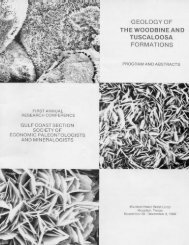Petroleum Systems of Deep-Water Basins - Gulf Coast Section SEPM
Petroleum Systems of Deep-Water Basins - Gulf Coast Section SEPM
Petroleum Systems of Deep-Water Basins - Gulf Coast Section SEPM
You also want an ePaper? Increase the reach of your titles
YUMPU automatically turns print PDFs into web optimized ePapers that Google loves.
The Northern Angolan Margin Imaged by<br />
Wide Angle Seismic Data<br />
Joaquim Boavida<br />
Geophysical Department<br />
University <strong>of</strong> Luanda A. Neto<br />
Luanda, Angola<br />
e-mail: calema@netangola.com<br />
Giancarlo Biella<br />
C.S.G.A.Q., National Research Council<br />
Via Bassini<br />
15 20133 Milano, Italy<br />
e-mail: biella@irrs.mi.cnr.it<br />
Roberto de Franco<br />
C.S.G.A.Q., National Research Council<br />
Milano, Italy<br />
Dario Luzio<br />
Geophysical Department<br />
University <strong>of</strong> Palermo<br />
Palermo, Italy<br />
Alfredo Lozej<br />
Earth Science Department<br />
University <strong>of</strong> Milano<br />
Milano, Italy<br />
Zaiango Group<br />
Ifremer, France<br />
“Terra-Mar” Group<br />
University <strong>of</strong> Luanda and Endiama, Angola<br />
CGUL, Portugal<br />
CNR, Milano, Italy<br />
DISTER, Genova, Italy<br />
INGV, Roma, Italy<br />
Abstract<br />
Wide angle seismic data collected on land in Northern Angola during the March-April 2000 Zaiango seismic<br />
experiment provide the first detailed image to date <strong>of</strong> the whole crust down to the upper mantle on the Northern<br />
Angolan margin.<br />
Travel times <strong>of</strong> P-wave refracted arrivals and prominent crustal and mantle reflectors observed to <strong>of</strong>fsets <strong>of</strong> over<br />
200 km were used to model a crust/mantle boundary, which beneath the continent rises in an oceanward direction,<br />
from 40 km to 25 km. In the center <strong>of</strong> the line, where the crust thins most rapidly, a high velocity body has been interpreted<br />
at the base <strong>of</strong> the crust, reaching some 8 km in thickness. This higher velocity body is thought to represent an<br />
area <strong>of</strong> localized magmatic underplating related to the opening <strong>of</strong> the South Atlantic and to the Cenomanian volcanism<br />
in Angola, as well as the late uplift <strong>of</strong> the mainland, which may have deep rooted causes.<br />
25

















